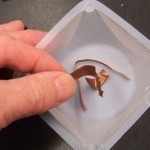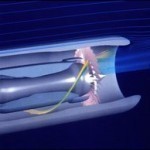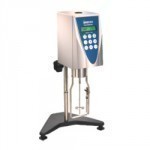There are three primary colors in light that, when mixed together, form other colors. These primary colors in light are green, red and blue. For example, by mixing and matching the different wavelengths of light, someone can take green and red and make yellow. It is this constant mixing of light wavelengths that allows for different colors to appear. Each primary color, when mixed with another primary color, makes a totally different color. The following are the different possible colors that can be made when mixing the different primary colors Read More
What is Phosphorescence?

Phosphorescence is an effect in which some chemicals re-emit light that they absorb. It is similar to fluorescence, except that the chemical reactions within phosphorescent materials happen less often, thus they take longer to emit light. Phosphorescent materials can be recharged by being exposed to light and may store light for several hours before it is re-emitted. Phosphorescence and fluorescence make up the vast majority of glow-in-the-dark products, with fluorescence generally being used in situations that involve a steady power source and phosphorescence being used in situations that do not. Read More
Exoskeleton for Humans
Exoskeletons, in the natural state, refer to the hard shell or 'skins' of insects (such as beetles and cockroaches) and crustaceans (shrimps and crabs). An exoskeleton is a hard outer structure which provides form, structure, protection, and support to the 'soft' inner workings of a creature. This is unlike that of birds and other animals (including humans) where the skeleton is "internal" – the bones and internal organs are covered by skin, fur or feathers. The key difference is protection. The exoskeleton in insects and crabs act as armor for Read More
DNA Origami
Folding DNA to create different two or three dimensional shapes while at the nano level of size is known as DNA origami. By relying on the interactions between complementary base pairs, one is able to manipulate a long strain of DNA and force it to fold and twist in such a way as to create different designs. The original project required a process of taking a long strain of viral DNA and bending it and twisting it with the help of staple strands. These strands would bind to the long Read More
What is Malleability?

Malleability refers to metals’ (and other hard materials’) ability to be stretched, shaped, or molded through applied pressure. While not all objects are malleable, most metals are. This is the reason that metals such as gold, silver, and platinum, are used to make jewelry and electronic circuits. Malleable objects can usually be reshaped and molded around other objects when pressure is applied to them via a hammer or roller. How Malleability Works Physical changes in metal are responsible for its deformation. When a malleable metal is compressed, individual molecules Read More
Teleportation
In 1931, Charles Fort, an American writer, tried to describe the random disappearances and appearances of different anomalies. He felt that these sudden disappearances and appearances were connected and therefore felt that they were "teleporting." While he came up with this theory to try and explain why certain paranormal phenomena acted, many suggest that Fort probably didn't subscribe to the theory and was using it as a way of suggesting mainstream science didn't provide enough information on why these phenomena happened. Dematerialising This is the transmission of data from one Read More
How Thunderstorms Form

There are three stages to a thunderstorm’s life cycle: the cumulus stage, the mature stage, and the dissipation stage. When a thunderstorm begins to form, it does so at the cumulus stage. From there, the storm advances in severity until it reaches its peak at the mature stage and then begins to gradually die out as it enters the dissipation stage. The Cumulus Stage The cumulus stage is the first stage of formation for any thunderstorm and is characterized by a few noticeable factors. First off, a thunderstorm starts by Read More
How to Add Fractions

The ability to add fractions is a skill that many learn in elementary school and by the time they graduate from high school, seem to have forgotten because it is a skill used so sparsely. However, a quick mind refresh of the steps reveals that adding fractions is a straight forward process that requires three very basic steps. These steps, when combined with an understanding of what a fraction is makes solving addition of fractions very simple. To begin with, a fraction is a part of a whole. For example, Read More
Pulse Jet Engines

A pulse jet engine is a type of jet engine that uses pulses of combustion rather than continuous combustion to stay in the air, thereby reducing fuel costs and increasing efficiency. While pulse jet engines have been used in many functional jets, they can also be used for a variety of other applications such as water heating, biomass fuel conversion, fog generators, radio controlled aircraft, target drone aircraft, control line model aircraft, and pulse detonation experiments. Pulse jet engines are most often used in unmanned aircraft due to problems with Read More
Brookfield Viscometer

The Brookfield Viscometer makes it possible to measure viscosity by employing techniques in viscometry. Viscometers (which can also be called viscosimeters) can measure viscosity through the varying flow conditions of the sample material being tested. They employ a spindle on a shaft that is designed to be dipped or immersed into a liquid that is then rotated. The rotation causes the fluid to produce a drag, which is then measured with the applied torque on the liquid’s viscosity. They are not designed to measure multiple flow conditions, but are possible Read More


Share on: